Museumswelt Hüttenberg
Schaubergwerk Knappenberg
Useful Information
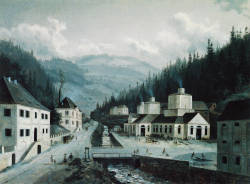
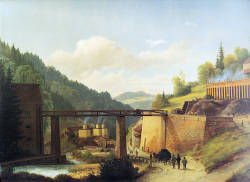
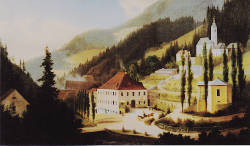
| Location: |
Knappenberg 32, 9376 Knappenberg.
(46.9334343, 14.5709266) |
| Open: |
MAY to JUN Thu-Sun, Hol 10-17. JUL to AUG daily 10-18. SEP to OCT Thu-Sun, Hol 10-17. [2025] |
| Fee: |
Adults EUR 15, School pupils EUR 9, Students EUR 13, Seniors EUR 13, Disabled EUR 13, Families (2+*) EUR 30. Groups (10+): Adults EUR 13, School pupils EUR 8. Hüttenberg Card: Adults EUR 19, School pupils EUR 13, Students EUR 15, Seniors EUR 15, Disabled EUR 15, Families (2+*) EUR 45. Groups (10+): Adults EUR 15, School pupils EUR 10. [2025] |
| Classification: |
 Iron Mine Iron Mine
 Slag Heap Slag Heap
|
| Light: |
 Incandescent Incandescent
|
| Dimension: | A=800 m asl. |
| Guided tours: | D=60 min. |
| Photography: | |
| Accessibility: | |
| Bibliography: |
Bruno Baumgärtel (1903):
Der Erzberg bei Hüttenberg in Kärnten
in: Jahrbuch der k.k. Geologischen Reichsanstalt, Jg. 52, Wien 1903, S. 219–244.
pdf

Ferdinand Seeland (1876): Der Hüttenberger Erzberg und seine nächste Umgebung in: Jahrbuch der k.k. Geologischen Reichsanstalt, Jg. 26, Wien 1876, S. 49–112. pdf 
|
| Address: |
Schaubergwerk Hüttenberg, Knappenberg 32, A-9376 Knappenberg, Tel: +43-4263-427 or +43-4263-8108.
E-mail: Tourismusbüro Hüttenberg, Reiftanzplatz 18, 9375 Hüttenberg Tel: +43-4263-8108. E-mail: |
| As far as we know this information was accurate when it was published (see years in brackets), but may have changed since then. Please check rates and details directly with the companies in question if you need more recent info. |
|
History
| 500 BC | first mentioned. |
| 1567 | construction of Erbstollen started. |
| 1978 | mine closed. |
| 1980 | show mine opened to the public. |
Geology
The Hüttenberger Erzberg in the Seetal Alps was named after the village of Hüttenberg, which got its name from the ironworks. The mountain consists of mica schist of the Middle East Alpine crystalline complex, in which ferrous marble trains are embedded. These iron ores have a high iron content and are known as Ferrum Noricum (Noric iron) because the region was called Noricum in Roman times. Brown ironstone dominates at the top and spar ironstone at lower levels, while there are also smaller deposits of pyrite and barite. These ore deposits are the result of volcanic activity, which heated the rock, transported the iron hydrothermally and dissolved the marble and replaced it with various iron minerals. This enrichment is called hydrothermal, and is characterised by the high ore quality, but also by the large number of different ores and the often small ore bodies whose extraction is complex.
Description
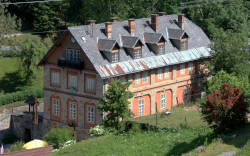

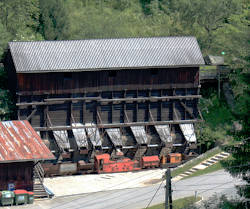

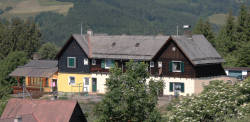
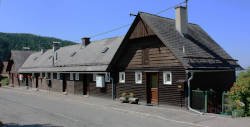
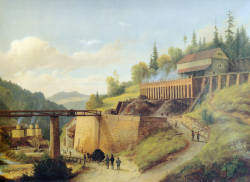
The municipality of Markt Hüttenberg has a large number of museums, but they are spread across several districts. The whole thing is a bit complicated, so let’s start by trying to sort out the confusion of names. All the museums operate under the name Museumswelt Hüttenberg, and you can even buy the Hüttenberg Card, which costs just four euros more than a single ticket and allows you to visit all the museums. Once again: with a 25% surcharge, I can visit half a dozen museums instead of one, and even on different days, because you can’t do it on one day. In addition to the mining museums, I can also visit the Heinrich-Harrer-Museum and the Helga Riedel Doll Museum.
The show mine, the mining museum and the mineral collection are located in Knappenberg, which is why they are logically called the Schaubergwerk Knappenberg (Knappenberg show mine) and so on. The Puppenmuseum Helga Riedel (Helga Riedel Doll Museum) is located directly opposite, and even if it doesn’t quite fit the theme, it is certainly worth a visit. The iron ore was smelted right here, the smelter is practically a separate village to the north of Knappenberg and is known as "Die Heft", and the Freilichtmuseum Heft (Heft open-air museum) can be visited. Further south is Lölling, a small village with a private museum and a small open-air museum. This is the Schmiede- und Schlossereimuseum Lölling (Lölling Blacksmith and Locksmith Museum) in the cellar of the Neugebauer country inn, which shows how iron is processed. There are also the ruins of the Erzquetsch, where the ore was "quetsch" (squeezed) using water power. In the main town, the market town of Hüttenberg, there is also the Harrer Museum.
The Schaubergwerk Hüttenberg (Hüttenberg show mine) is located inside the 900 m long Erbstollen. This is an adit which was started in 1567 and drained the iron mine. Today the adit is used as a sort of underground museum showing the mining technology of 2,500 years, the transport of air into the mine, and water out of it. The visitor is also informed about Saint Barbara, the Patron Saint of the miners. And finally some local myths and legends about the mining are told.
The Bergbaumuseum Knappenberg (Knappenberg Mining Museum) tells of the hard work, life and traditions of the miners. This also includes the Hüttenberger Reiftanz, the last completely preserved men’s chain dance in Central Europe. It is performed by the Hüttenberg miners every three years on the first Sunday after Whitsun. In addition to historical working tools, there is also an extensive collection of miners’ lamps. One section focuses on surveying and blasting technology. The highlight of the historical section is the famous Hüttenberger Bergwerksordnung (Hüttenberg Mining Code) of Empress Maria Theresa. The museum is located on the ground floor of the former mine house, right next to the mouth of the Erbstollen.
The Mineralienschau (mineral show) on the first floor of the mine house is a collection of more than 200 different minerals from this mine. One of the minerals is called Löllingite, named after the nearby village of Lölling. Typical local minerals are quartz varieties such as rock crystal, amethyst and chalcedony, but also malachite, calcite, pyrite and many others. The museum also houses the office of mineralogist Heinz Meixner. The Albert-Halde (Albert dump) is a spoil heap from the old mine and is accessible to mineral collectors. It is said to be the third-largest mineral collecting site in the world, whatever "large" means in this case. A famous mineral fair is held in the town on the first weekend in July.
Die Heft, now the Freilichtmuseum Heft (Heft Open-Air Museum), is one of the largest 19th century ironworks in Europe. It is an open-air museum with numerous buildings and blast furnaces. The Johann-Ernst and Pulcheria charcoal blast furnaces were built in the classicist style. A floating glass and steel construction was built for the Carinthian Provincial Exhibition in 1995 according to the plans of architect Günther Domenig. The ore was transported to Heft on an ore railway, which has now been dismantled and serves as a hiking trail, although remains of the inclined lift used to transport the ore down to the valley still exist.
The Knappenberg has a very long history, mining has been practised since the Celtic period around 2,500 years ago. They sold their iron to Rome, where it had a very good reputation because even then it was of a quality that almost equalled that of steel. Eventually Rome expanded across Central Europe and this area became the Roman province of Noricum, the iron was called Ferrum Noricum (Noric iron). The Romans actually mined here, the iron was smelted in shaft furnaces and then the iron flakes were processed by blacksmiths into swords and other items. The phosphorus content and the skill of the smiths were essential for the quality. In 860, Hüttenberg came to the Archbishopric of Salzburg, which had mining rights over all mineral resources. In 1805, Salzburg became part of Austria and the Hüttenberg ore mountain became one of the most important ore deposits of the monarchy. Most of the preserved mining monuments and buildings with mining references date from the second half of the 19th century. In fact, iron ore mining here was much more successful than most other European mines, except for the nearby Erzberg. When many iron mines and smelting works closed in the middle of the 20th century, it managed to survive. However, it was finally closed in 1978 and after closure work, mining finally came to an end in 1980.
On the one hand, the show mine was probably an attempt to convey the history of mining and to preserve at least a small part of the facilities. Perhaps this was also linked to the hope of offering at least a small number of the miners who had become unemployed a professional alternative. After all, the town had lost an important employer. It was built by the "Friends of the Hüttenberg Show Mine Mining Museum" association, which is why we chose the name "Hüttenberg Show Mine". However, the municipality simply wrote "Schaubergwerk" on its website until Corona and recently decided to use the name "Schaubergwerk Knappenberg". After the end of smelting, the region became known as a climatic health resort for its high air quality. There are now a number of mining history nature trails, including the railway line of the light railway from Globitsch-Bremsberg to the Hefter blast furnaces.
Knappenberg is the birthplace of the famous Austrian Heinrich Harrer. He was a mountaineer and was used by the Nazis for propaganda, which he was probably happy to do at first because of the fame associated with it. When he was on an expedition to the Himalaya, World War II started, and he was imprisoned by the British in India. He escaped with his mountaineer colleague and walked to Tibet. This story is told in the movie Seven Years in Tibet. The town Knappenberg has a museum about his life and the culture of Tibet.
- See also
 Search DuckDuckGo for "Schaubergwerk Hüttenberg"
Search DuckDuckGo for "Schaubergwerk Hüttenberg" Google Earth Placemark
Google Earth Placemark OpenStreetMap
OpenStreetMap Schaubergwerk Knappenberg
Schaubergwerk Knappenberg  - Wikipedia (visited: 02-JUN-2025)
- Wikipedia (visited: 02-JUN-2025) Hüttenberger Erzberg
Hüttenberger Erzberg  - Wikipedia (visited: 03-JUN-2025)
- Wikipedia (visited: 03-JUN-2025) Schaubergwerk Knappenberg
Schaubergwerk Knappenberg  (visited: 03-JUN-2025)
(visited: 03-JUN-2025) Schaubergwerk & Mineralien Knappenberg
Schaubergwerk & Mineralien Knappenberg  (visited: 03-JUN-2025)
(visited: 03-JUN-2025) Hüttenberger Erzberg
Hüttenberger Erzberg  (visited: 03-JUN-2025)
(visited: 03-JUN-2025)
 Index
Index Topics
Topics Hierarchical
Hierarchical Countries
Countries Maps
Maps